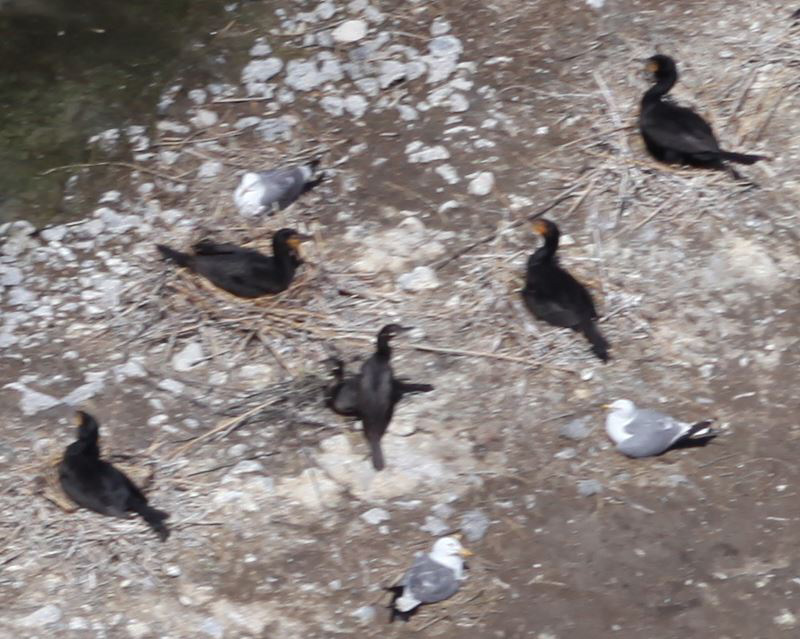 |
||
| Common name: |
Neotropic Cormorant |
|
| Scientific name: | Phalacrocorax brasilianus | |
| Date: | 5/29/2019 | |
| Time: | 11:54 am | |
| Length of time observed: | Identified from photo | |
| Number: | 2 | |
| Age: | Adults | |
| Sex: | Presumably, 1 female and 1 male | |
| Location: | Location: Bear River Migratory Bird Refuge, Unit 4B | |
| County: | Box Elder | |
| Latilong: | 41.417758, -112.197096 | |
| Elevation: | ~4,208 | |
| Distance to bird: | ~400 feet | |
| Optical equipment: | Canon EOS 5D Mark II with Canon 35-350 mm zoom lens | |
| Weather: | Did not record but Corinne weather station data recorded 63.5 F temperature and wind of 5.91 WSW gusting to 9.31 mph at 12 noon. | |
| Light Conditions: | Sunny | |
| Description: Size of bird: | Pheasant | |
| (Description:) Basic Shape: | Cormorant | |
| (Description:) Overall Pattern: | Black | |
| (Description:) Bill Type: | About length of head | |
|
(Description:)
Field Marks and Identifying Characteristics: |
Nesting pair of Neotropic Cormorants. Possibly the first document nest in Utah.
Two cormorants were together, and one appears to be on a rudimentary stick nest
with its mate standing next to the nest. The nest is among a Double-crested
Cormorant colony. The two cormorants in question are noticeably smaller and
slimmer than nearby (~4 feet) nesting Double-crested Cormorants. White border of
gular pouch visible on both adults although the "V" shape is indistinct. White
filoplumes are visible on the standing adult and are directly to the rear of the
white border of the gular pouch. The body and the long, narrow tail feathers are
all black. Color of gular pouch is not visible compared to Double-crested
Cormorants. (see photos) |
|
| Song or call & method of delivery: | NA | |
| Behavior: | Sitting and attending a nest within a nesting colony of Double-crested Cormorants, Great Blue Herons, and California Gulls. | |
| Habitat: | Mostly barren and flat island within a managed impoundment. | |
| Similar
species and
how were they eliminated: |
There are only two cormorant species known to Utah, so the only other similar species to eliminate is the Double-crested Cormorant. With nearby comparison possible in the photo, the Double-crested Cormorant is eliminated by its larger, bulkier size and the obvious presence of its orange gular pouch without a white "V" border. Although Neotropic Cormorants have an orange gular pouch as well, the smaller size of Neotropic Cormorants, the perspective of the photo, and the boldness of the white "V" hide the color of the gular pouch. A young Double-crested Cormorant that is still within the nest may appear similar to a Neotropic Cormorant adult due to their smaller size, but a juvenile lacks the white "V" and filoplumes. Although, the gular pouch of juvenile Double-crested Cormorants may appear similar to a white "V" in the colony photos, the color is more yellow than white, and juvenile Double-crested Cormorants lack white filoplumes. Also, the nesting chronology of a Double-crested Cormorant colony tends to be synchronous. Since nearby nesting Double-crested Cormorants were still on eggs or small nestlings, it is highly unlikely that the Neotropic Cormorants were juvenile Double-crested Cormorants. | |
| Previous
experience with this & similar species: |
Annual observations of Neotropic Cormorants. Very familiar with Double-crested Cormorants. Colonial nesting survey for cormorants is done every year. | |
| References consulted: | The Sibley Field Guide to Birds of Western North America-First Edition and https://www.allaboutbirds.org/ | |
| Description from: | From photo(s) taken at the time of the sighting | |
| Observer: | John Neill | |
| Observer's address: | 4790 S. 7500 W.; Hooper, UT 84315 | |
| Observer's e-mail address: | ** | |
| Other observers who independently identified this bird: | NA | |
| Date prepared: | 9/17/2019 | |
| Additional material: | Three photos of the Neotropic Cormorants, but only one has sufficient detail. Photos (22) were taken of the whole island colony. | |
| Additional comments: |
Photos of the Neotropic Cormorants were taken as part of an annual aerial survey
of colonial nesting waterbirds around Great Salt Lake and northern Utah, which
focuses on Double-crested Cormorants, American White Pelicans, and Caspian
Terns. The digital photos were taken from an airplane (Cessna 185) through an
open window and later analyzed on a computer. Time given is from the time stamp
on the photo. Sight record descriptions are based on photos. This record, based
on one photo, is also on eBird at
https://ebird.org/view/checklist/S59858180. |
|